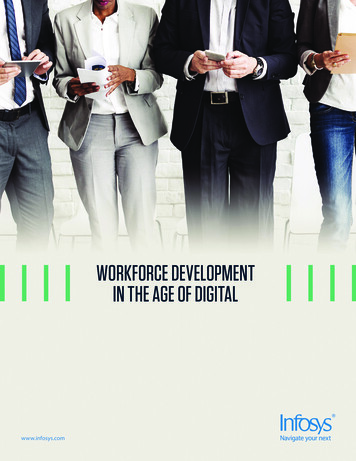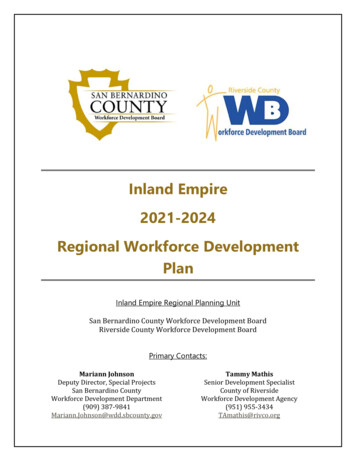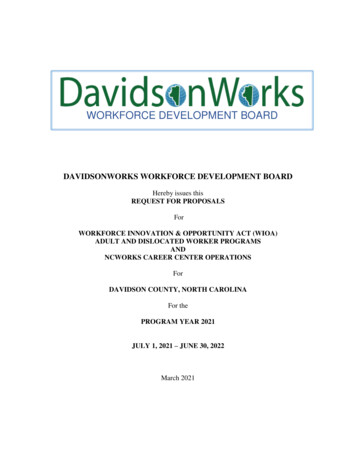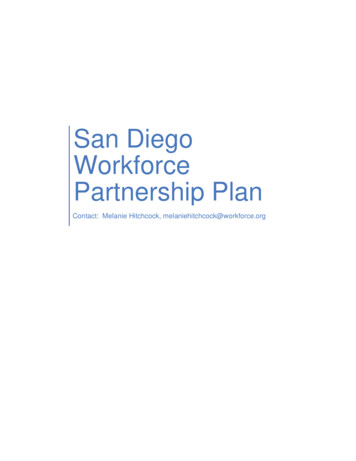
Transcription
WORKFORCE DEVELOPMENTIN THE AGE OF DIGITALInfosyswww.infosys.comWorkforce Development in the Age of Digital1
2InfosysWorkforce Development in the Age of Digital
ForewordThe tale of the U.S. job market isone of contradiction. An increasingnumber of jobs are being lost tointelligent automation, but theunderlying digital technologies inuse are also creating new roles thatare going unfilled due to a severeskills shortage.The technology skills of the pastmostly centered on programming,which was easily executed by STEMtalent. With digital skills evolvingfaster and becoming more pervasivein the world of business, talent from avariety of disciplines with capabilitieshoned in corporate ‘finishing schools’must now be prepared for these jobsof the future.A new approach to workforcedevelopment is needed, which is whyInfosys has developed and scaleda program in the United States toaddress this shortage—training talentfrom a variety of backgrounds anddisciplines from across the country fora more digital future.Our model for workforcedevelopment recognizes privateenterprise must play the lead rolein embracing workforce transformation to solve the talent crisis.With technology roles growingexponentially within companies, it isunrealistic to look to fill all these openpositions with graduates with 4-yeardegrees. These jobs can be performedby non-degree holding workerswith the right specialized skills thatcan be nurtured through alternativeeducation paths. To do so, we mustrecruit and train people with theability to learn quickly and apply thatlearning to newly developed skillsand digital approaches. AlthoughInfosystechnical skills such as codingand data science are important,soft skills (including a strong workethic, self-motivation, and social,emotional, and leadership skills) andholistic skills (like problem-finding)are the key components for successin today’s economy. This is obviouslynot predicated on the discipline inwhich one graduates, but on one’sability to learn and continuouslyoperate with a fluid, flexible setof contemporary skills that areconstantly improving, on the job.This means the linear, educationto-employment equation must giveway to the continuum of lifelonglearning. This is the only surefireway to guarantee workers stay onthe cutting edge of all that’s neededfor the future. That is why Infosyshas created on-demand learningfor employees, delivered throughexperiential means, which they canaccess throughout their time with thecompany. By substantially and continuously investing in the training of ourpeople, we are not only removingbarriers which would otherwise haveprevented them from fully participating in the modern economy, weare also ensuring that our workforceremains at the forefront of all that’srelevant for the future.And that future is exciting. Withthe proper background and skills,American workers can becomeeven greater problem-finders andcreative problem-framers by utilizingmachines to be their efficientproblem-solving partners. At Infosys,we have moved toward employinga mixture of full-time employees,gig workers, and software-ledintelligence. While the gig talentpool flexibly scales human enterpriseWorkforce Development in the Age of Digitalwhenever required, the software-ledintelligence provides the insights andanalytics that guide people in theirpursuit of problem-finding and theautomation to create bandwidth fortheir creative work.Today, with the support of ouracademic, government, and businesspartners, Infosys has created a modelfor workforce development in theUnited States that is both scalableand relevant to companies in everyindustry. This model also includesthe propagation of computer scienceas a foundational skill to be taught inAmerican public schools—an agendadriven by Infosys Foundation USA.That is why I am pleased to sharethis report, which incorporatesboth quantitative and qualitativeresearch to explain and demonstratethe value of such an approach. Thelessons we have learned will serveothers well too.The United States, and the globaleconomy, are at a crossroads. Thereis a gap between the skills businessesrequire and the skills workers possess,and there is an important role forbusinesses to play in overcoming thatchallenge. Businesses must step intothe divide and create pathways forworkers across the talent spectrum tolearn, train, and succeed. By preparingthe workforce of today for thechallenges that lie ahead, we can seizethe opportunities the digital economypresents us and unleash a new age ofinnovation and prosperity.Ravi Kumar S.President, Infosys1
ExecutiveSummaryThere are more science, technology,engineering, and mathematics(STEM) jobs in the United States thanthere are qualified people to fill them.Last year, 2.4 million STEM jobsremained unfilled1—a figure largerthan the population of Houston, thenation’s fourth-largest city.2 The gapis so wide and well-known that twoout of five Americans describe thesituation as “a crisis.”3The gap exists—and persists—due toa fundamental misalignment betweenacademic institutions and businesses.The economy for which colleges anduniversities have prepared their graduates is not the economy in whichbusinesses operate. In today’s digitalage, businesses increasingly needworkers who are fluent in digital skills,capable communicators, well-versedin logical and analytical reasoning,and geared toward problem-findingrather than just problem-solving.FEEDBACK THAT SCHOOL ADMINISTRATORSRECEIVED FROM EMPLOYERS28%say graduating students lack thenecessary communication skillsVS.11%say graduating students lack thenecessary digital or technical skills2This misalignment threatens toleave businesses incapable of fillinghigh-value roles, and it means theU.S. economy misses out on ideas,services, products, innovation, andof course, growth. The Bureau ofLabor Statistics forecasts the numberof STEM-related jobs in America willgrow steadily until 2024 (they did notforecast any further), 4 likely enlargingthis gap between job openings andcapable candidates.STEM jobs haveDOUBLEDas a proportion of alljobs worldwide since theIndustrial Revolution.Source: The Smithsonian ScienceEducation CenterMost discussions on how to closethis gap arrive at similar solutions:more students need to study STEMsubjects at all grade levels; moreschools and universities need toprovide STEM courses; and the federalgovernment should encourage skillsbased STEM programs in schools andin the workforce.These are crucial steps, but each—and all—would likely take yearsto implement. And perhaps moreimportantly, this discussion missesthe larger point. While there is a greatneed for more STEM talent, whatbusinesses truly need is more STEMcapable talent—workers who havethe aptitude to learn digital skillsand continue to evolve that skillsetInfosysthroughout their careers. The digitaleconomy will not allow for workersto make a career out of expertisein one area alone. Rather, workersmust be prepared to adapt to theconstantly changing skill needs ofthe modern economy.This is why it is so concerning thatthe private sector has been noticeablyabsent from the conversation.The private sector, which has theresources—and incentive—to preparetoday’s workers and graduates tofill today’s vacancies and developthe skills for tomorrow’s challenges,must play a larger role in creatinga workforce capable of performingin-demand skills. Companies areuniquely positioned to help workersclear the two most common hurdlesto attain the training they need: lackof time and lack of money.75% of U.S. workers and hiringmanagers believecorporations must play agreater role in developing“unconventional” candidates.Source: Infosys Research on WorkforceDevelopment in the Age of DigitalWorkforce Development in the Age of Digital
This paper explores how Infosysis building a highly skilled localworkforce at scale and at speed anddoing so in an environment wheresuch skills were—and still are—inmeasurably short supply. It is doing soby investing in cities outside of SiliconValley, which are not traditionallyconsidered to be hubs for tech talent,including Indianapolis, Hartford, andRichardson, Texas.The centerpiece of this report isInfosys’ ongoing U.S. Talent Program:a commitment of 20,000 and upto twelve weeks of full-time trainingfor each American worker thecompany hires from schools, withno strings attached.Underpinning this initiative is arecognition that technical skills canbe taught to STEM and non-STEMworkers alike—and the privatesector is well-placed to do theteaching, especially to local talentwith the aptitude to be trained inthe broad-based skills necessary intoday’s and tomorrow’s economy.By broadening the aperture throughwhich Infosys views candidates andhires new workers, the companyis expanding the pool of potentialtalent. This approach has helpedInfosys hire more than 7,600 Americanworkers so far, and by the end of 2019,that figure is on pace to meet 10,000.Infosys6Technology andInnovation centers10,000 20KAmerican workershired by 2020spent on training each newemployee from schoolsINCT RINCAZTXInfosys’ investment in people hasbeen accompanied by its investmentin communities. The company hascommitted to establish and open sixTechnology and Innovation Centers inthe United States by 2020, includingCenters in Raleigh, North Carolina;Phoenix, Arizona; and Providence,Rhode Island, in addition to thethree cities listed previously. In thesecities, Infosys is not only buildingCenters, but also talent pipelines,and is partnering with universitiesand community colleges to providestudents with training, graduates withopportunity, and Infosys employeeswith the reskilling necessary to stayon the cutting-edge of innovation.Workforce Development in the Age of DigitalInfosys’ experience has shownthat while the skills issue is resistantto simplistic solutions, it is notinsurmountable. By providingopportunities, training, and financialsupport, Infosys has seen peoplefrom across the country performbrilliantly in highly technical, highlyskilled roles—roles for which theymight have been deemed unqualifiedhad only their diplomas or résumésbeen evaluated.This paper shares Infosys’ experience,the data which informed this initiative,and reflections from those involvedto show how companies can be partof the solution to today’s skills crisis—and be stronger for the effort.3
The Skills GapChallenges faced by studentsand workersA Shortage of Students—AndCapacityThe number of American STEMgraduates—568,000 in 2016—inno way approximates the country’scurrent STEM-related job openings.The U.S. needs to encourage morestudents to study STEM, especiallywomen and minorities. But as thenumber of STEM students graduallyrises, so too will the number ofSTEM-related employment opportunities (and very likely, vacancies),making it all the more necessaryto nurture and train STEM-capabletalent in the technical skills the digitaleconomy requires.A push to attract more studentsneeds to be accompanied by a moveto create more courses, hire moreprofessors, and create more capacity.A 2019 report in The New York Timesdescribed undergraduates’ strugglesto secure placement in STEM coursesat U.S. universities, with some collegesholding lotteries for computerscience courses while others wait-listhundreds of students for suchclasses. 5 Increased investment fromuniversities into STEM courses andprofessors would help to alleviate, butnot solve for, the gap that exists—agap that will remain without privatesector intervention.SINCE 2015134,0002,500568,0002,5004.7MGRADUATED WITHSTEM DEGREES IN : World Economic Forum,“Human Capital Report”4across America havebenefited from computerscience training andclassroom equipment fundedby Infosys Foundation USAInfosysBarriers Faced by Many Workers:Time and MoneyViewed through the lens of STEMskills, workers can be divided into twobroad categories: those with themand those without. Those with STEMskills are considered “conventional”talent—they have the background,the training, and the experience thatjobs in the field have long prizedand required. Those without thiseducation and experience are referredto as “unconventional.”Both kinds of talent have a role toplay in closing the STEM skills gap.According to a 2018 report by PewResearch Center, almost half ofworkers with college STEM trainingare working in a non-STEM job (likebusiness or finance).6 Clearly morecan be done to attract and retainconventional talent.If “unconventional” workers are tohelp bridge this STEM gap, they firstneed to acquire STEM skills. Researchcommissioned by Infosys askedworkers without STEM degrees to citethe biggest barriers to the pursuit ofSTEM credentialing opportunities.More than half (55%) said it wasthe “cost of the program,” while50% pointed to the “time neededto dedicate to the program.” Thus,Infosys’ initiative to pay motivated,capable workers a salary whilethey learn high-tech skills for up to12 weeks removes the two mostcommon barriers to doing so.Workforce Development in the Age of Digital
BARRIERS TO TRAININGCOST OF PROGRAM55%36%TIME NEEDED TO DEDICATE TO PROGRAM55%39%AVAILABILITY OF DIGITAL AND TECHNICALTRAINING IN THE %28%23%24%23%33%21%26%17%26%12%Basic computerskillsIT supportUserexperienceData analyticsUNABLE TO BALANCE PROGRAMWITH WORK RESPONSIBILITIES32%N/AUnconventional TalentCybersecurityTechnologydesignTraditional TalentPlenty of Training—But Qualityand Consistency in Short SupplyYet training clearly isn’t the onlyanswer to addressing today’s skillsshortage, as most American workersalready receive it in some form. Atits most effective, training teacheshigh-demand, cutting-edge skills, yetmany corporate training programsteach only rudimentary ones.Research by Infosys found that onlyhalf of U.S. hiring managers (54%)said their company offered training inbasic computer skills, and only one inthree said their company offered morespecialized training in cybersecurity(34%) or cloud computing (33%).Web or gCloudcomputingAutomationand AI supportIOTHiring ManagersInfosysWorkforce Development in the Age of DigitalTraditional Talent5
THE MEDIAN INVESTMENT FOREMPLOYEE TRAINING IN THE U.S.IS 1,000 PER EMPLOYEE,1/20THof Infosys’ commitment.Source: Infosys research on WorkforceDevelopment in the Age of DigitalContent matters, but so does theconsistency with which it is deliveredand updated. As technology changescontinuously, so do the skills requiredto use it and the problems that it cansolve (and create). Likewise, contentmust also be tailored to the recipient.Those solving for digital challengesfrom a systems-level perspective needto hone a different set of capabilitiesthan those developing and refiningemerging technologies. While allworkers need a basic digital fluency,variations in worker responsibilitiesrequire variable training regimensin specialized functions—trainingwhich must continue and evolve overtime in response to technologicaldisruption. These disruptions arehappening more quickly than everbefore, rendering skills, degrees, andcertifications in many STEM fieldsobsolete, or at the very least outdated,at a surprising rate.This problem is by no means uniqueto the American workforce. Accordingto a 2019 McKinsey report, 60 percentof global executives expect “up tohalf of their organization’s workforcewill need retraining or replacingwithin five years.” Almost three in 10executives “expect that more than half6of their workforce will need retrainingor replacing,” while roughly that samenumber said their organization wasunprepared to do so.7The InfosysInitiativeInvesting in people andcommunities and partneringwith universitiesThe Infosys Commitment: 20,000 and up to 12 Weeksof Training Per New Hirefrom SchoolsIn May 2017, Infosys launched its U.S.Talent Program from Indianapolis,committing to hire 10,000 Americanworkers and establish six Technologyand Innovation Centers across thecountry by 2020.It was—and still is—a decisioninformed by business practicalities:Infosys’ business relies on a skilled,motivated, and creative workforce.Infosys needs employees onthe ground, capable of workingside-by-side with clients in the U.S.,and building trusted relationshipswith them—providing the kind ofon-site, tailored solutions which justaren’t possible with offshore teams.“Yes, there is a cost to ourU.S. Talent Program, but it’swell worth the investment.Our program allows us toattract top talent and delivervalue to our clients.”- Srikantan Moorthy, Executive VicePresident, Global Head of Education,Training and Assessments, InfosysInfosysIt is also supported by research.A survey by Infosys found that“unconventional” talent identifiedtime and money as the most commonobstacles to STEM training—obstaclesthat also existed for 3 in 10 workerswith conventional backgrounds.Infosys’ U.S. Talent Program makesa recruit’s aptitude, work ethic, andpotential the determining factors, nottheir savings or degrees. Increasingly,clients’ problems are best solvedby teams of local, diverse, creativethinkers who can quickly learn andabsorb new skills, tackle complexproblems, communicate well, andhelp solve problems that haven’tyet emerged.And finally, the decision was informedby the Infosys corporate culture. Thebrevity of the word “training” beliesthe amount of thought, investment,and commitment that is required todo it brilliantly. An ethos of lifelonglearning has been central to Infosys’business since its founding in 1981.Central to this ethos is the belief thatthe relationship between educationand professional work is not linear.Infosys does not subscribe to theconventional view which holds thatcitizens learn first (in schools andcolleges) and earn later (in theirjobs)—as if to suggest that learningstops when earning begins. Toomany of America’s universities andemployers are still frozen in old ways,in which members of society studyfor their first 15 or 20 years, and thenwork for the rest of their lives. In thefuture, with the rapid evolution oftechnologies in the digital world,study and work will be a continuum.Workforce Development in the Age of Digital
RESOURCES TOOVERCOME BARRIERSOnline education courses totake at your convenience64%Employer-subsidized costs forcredential or certification programs60%Webinar series on real-worldexamples of STEM careers25%In-person training fromemployer to build necessaryproficiency requirements24%“The key for Infosys, what Ibelieve differentiates us, is aculture and a philosophy oflifelong learning.”- Ravi Kumar S, President, InfosysInformation on salaries andopportunities for careers17%“The larger legacy employersare accustomed to receivingstudents who come off theassembly line and then pluggingthem into their organization.But the model has changed. Wehave to figure out how we canhave ‘earn-and-learn’ models.”- Danny Lopez, Indiana Governor’sWorkforce Cabinet, ChairmanInfosysThat is why Infosys runs the world’slargest corporate education programfrom one of the world’s largestcorporate universities in Mysore, India.There, the company can train 14,000people on a single day, and Infosysleads a six-month program for everycampus recruit in Mysore. Infosysis currently constructing a similarcampus in Indianapolis—the InfosysU.S. Education Center—that will bethe largest training center developedby any technology services providerin the country, and one open torecruits and clients alike. It’s thisproven model of training and learningat scale that the company is bringingto the United States.Innovation Centers andAcademic PartnershipsAlong with the company’sannouncement to hire 10,000American workers, Infosys will opensix Technology and InnovationCenters in the U.S. by 2020. Thefirst Center opened in March 2018in Indiana. Other Technology andInnovation Centers have beenopened or are being built in NorthCarolina, Connecticut, Arizona, andTexas, as well as a Digital Designand Innovation Center in RhodeIsland, each with its own uniquefocus on discrete digital capabilities.These Centers are not simply officeWorkforce Development in the Age of Digitalspaces for new employees. They areconvening grounds for collaborativework with clients, allowing Infosysto develop agile solutions to clients’challenges. They are training centers,bringing together Infosys’ top-tiereducators to train and nurture thenext generation of talent. TheseCenters collectively represent thephysical manifestation of Infosys’hiring and workforce developmentefforts and are integral to thecompany’s localization strategy.These Centers also feature complementary sets of accompanyingacademic partnerships. In 2018 Infosysentered into a five-year partnershipwith one of Indiana’s largest colleges,Purdue University, with an aim to trainmany of the 3,000 hires Infosys willmake in Indiana. By the end of 2020,when Infosys opens its U.S. EducationCenter, these partnerships will formintegral components of Infosys’overall training program—preparingstudents and graduates to beindustry-ready.Ensuring students are industry-readyis the same goal Infosys has forits partnerships with communitycolleges, such as Wake Tech inNorth Carolina and the CommunityCollege of Rhode Island. Thesepartnerships seek to unlock thepotential of community collegestudents, recognizing that communitycollege graduates possess the talentand aptitude to pursue careers inthe digital economy. With morethan one-third of all U.S. collegestudents enrolled in communitycolleges, 8 it is critical to the growthand success of the U.S. economy todeliver these students relevant skills7
as well as meaningful, real-worldlearning experiences designed toprepare them for technology careersimmediately upon graduation.Perhaps as important, thesecommunity colleges are deliveringto the business community studentswho are prepared to learn andevolve throughout their careers.By pairing tangible, technical skillswith the knowledge and capabilityto learn new skills over the courseof a career, these partnerships arepreparing a large and growing poolof potential talent for the realities ofthe modern economy.“All institutions ofhigher education, includingcommunity colleges, have afundamental obligation toprovide students with thelearning, skills, and experiencethey will require to secure theirfirst job after graduation andcontinue to grow in a rapidlychanging modern economy.”- Dr. Meghan Hughes, President ofCommunity College of Rhode IslandAnd just as Infosys has investedin “unconventional” talent, so toohas it focused on hiring for highlytechnical roles from schools nottraditionally thought of as producingSTEM talent, such as the RhodeIsland School of Design and TrinityCollege, a traditional liberal artsschool in Connecticut. The skills andperspectives these design and liberalarts graduates bring to Infosys allowthe company to more effectivelycreate human-centric solutions toclient challenges.8learning capabilities, Wingspanprovides tailored and relevantlearning recommendations, as well asguidance, to keep employees on thecutting-edge of innovation.“Liberal arts students area different, and maybeunconventional source offuture employees for thetechnology industry, but theyare doing a great job adapting to technological positionsbecause: one, they know howto learn; two, they’ve learnedsome of those soft skills thatallow them to work with allkinds of people; and three,they come in with verystrong oral and writtencommunications skills.”Infosys’ training programs withacademic institutions also providespecialized learning opportunities.Through Infosys’ partnership withonline university Udacity, for example,the company offers 10-week trainingprograms on subjects rangingfrom user experience to Java, fromtesting to automation. The programscombine lectures and hands-onprojects that teach trainees core,emerging, and methodology skillswhile simulating time-constrained,pressure-filled environments.- Dr. Joanne Berger-Sweeney,President of Trinity CollegeTraining Snapshot: Anytime,Anywhere, Any DeviceThe tenure and topics of recruits’training programs are tailored to theirbackgrounds and roles, but mostreceive an overview of core technologies as well as emerging ones,and later learn foundational skills inenterprise application development.Then, depending on the role for whicha recruit has been hired, they branchoff into one of 40 specializations:a deep dive into user interfaces orapplications, big data, or machinelearning. It’s a continuously updatedmodel which recruits can accessanytime, anywhere, using any device.“We have a group of almost 600educators in the company whoare focused exclusively on providing education interventionsto our employees. Their job isnot only training people, butalso creating new curriculum.”- Srikantan Moorthy, Executive VicePresident, Global Head of Education,Training and Assessments, InfosysEmployees similarly enjoy readilyavailable, specialized training. Lastyear, Infosys launched Wingspan, atraining tool providing best-in-class,curated content from multiple sourcesthat employees can access to enrichtheir knowledge. With machineInfosysWorkforce Development in the Age of Digital
ClosingThe alarm about a shortage of skilledtalent has been sounded before inthe U.S., and thanks to meaningfulaction, genuine past concerns cannow be classified as successfullyaverted crises. In 1945, the Directorof the Office of Scientific Researchand Development prophesied theUnited States “will enter the postwarperiod with a serious deficit in ourtrained scientific personnel.” Less thana decade later, the president of MITwarned, “Our national welfare, ourdefense, our standard of living couldall be jeopardized by the mismanagement of this supply and demandproblem in the field of trainedcreative intelligence.”competitiveness and growth.”9The only real question is whethercompanies which are capable ofhelping to close this skills gap will doso. No one company, nor academicinstitution, nor government can dothis alone. It will take a concertedeffort among business, academia, andgovernment, but, in Infosys’ view, it isan effort well worth making.“We are now applying ourexperience of training a globalworkforce to help grow local,highly skilled workforcesacross the U.S.”- Ravi Kumar S, President, InfosysToday, there is little doubt about thescale of the skills gap, its importanceto the business community, or theeffect on the national economy.The U.S. Department of Labor wrotethat “STEM fields have becomeincreasingly central to U.S. rkforce/Workforce Development in the Age of ege-FAQs.html9https://www.doleta.gov/youth services/pdf/STEM Report 4%2007.pdf9
For more information, contact PR Global@infosys.com10InfosysWorkforce Development in the Age of Digital
development is needed, which is why Infosys has developed and scaled a program in the United States to address this shortage—training talent from a variety of backgrounds and disciplines from across the country for a more digital future. Our model for workforce development recognizes private enterprise must play the lead role











